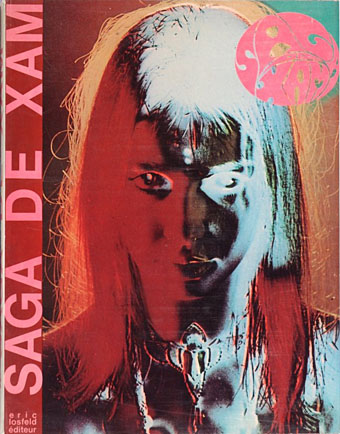
Saga de Xam, a large-format comic book published by Éric Losfeld in 1967, is another example of French erotic psychedelia that remained off my radar until I got my hands on the exhibition catalogue for the Musée d’Orsay’s Art Nouveau Revival show in 2010. The glorious drawing below was used as the background for the exhibition poster, and appeared inside the catalogue with two more pages from this rare and sought-after book, described in the catalogue as “the best and most precocious example of French BD directly inspired by American psychedelia”.
Éric Losfeld is a fascinating character, a kind of pop-culture equivalent of Maurice Girodias, the founder of Olympia Press. Both men published erotic novels, and both had problems with the authorities as a result; but Losfeld also found a niche in art and graphics, producing albums of erotic comic strips—Jean-Claude Forest’s Barbarella, Guy Peellaert’s Jodelle and Pravda, Guido Crepax’s Valentina, Philippe Caza’s Kris Kool—and lavish portfolios from the weirder end of the erotic art spectrum, showcasing work by Raymond Bertrand, Jean-Marie Poumeyrol and others. It’s common for Brits to consider France a more enlightened nation where sex and comic-art is concerned but in the 1960s comics in France were considered an unsuitable medium for sexual material. Many of Losfeld’s comic-books of the late 60s and early 70s endured the kind of censure that was occurring in Britain and elsewhere. An early non-erotic title was Lone Sloane: Mystère des Abîmes in 1966, the first Lone Sloane story by Philippe Druillet. This no doubt explains Druillet’s involvement with Saga de Xam a year later.

Saga de Xam: les créateurs.
The comics by Forest, Peellaert and Crepax all featured attractive (often naked) woman as their lead characters. Saga de Xam continued the trend, a story in seven chapters that reads like an amalgam of all the comics Losfeld had published up to that point, Druillet included. The book is credited to Nicolas Devil, and based on a scenario by film director Jean Rollin. (Druillet would later design some posters for Rollin’s vampire films.) Devil, aka Nicolas Deville, was one of Rollin’s art directors who also worked for a time as a comic artist and illustrator. For Saga de Xam Devil was the principal artist in the first six chapters, and wrote most of the text and dialogue. In the final chapter other hands are involved: Jim Tiroff, an actor from Julian Beck’s Living Theatre, provided a poem in English, while the artwork is an unusual exercise in the Surrealist “Exquisite Corpse” technique with Devil, Druillet and several other artists—Barbara Girard, Merri, Nicolas Kapnist—collaborating on a series of improvised splash pages. The final chapter also features arrangements of text that resemble layouts from avant-garde art magazines. Druillet’s contributions are easy to identify since they resemble invasions from his Lone Sloane series, even including references to the Necronomicon.
As to the story, this is science fiction à la Barbarella but with more of a moral and political slant. Saga is a blue-skinned young woman from the planet Xam whose adventures among a brutish humanity lead her to quickly lose her clothes and her illusions about the inhabitants of Earth. My poor French isn’t up to translating all the dialogue so for a précis I’ll resort to a Google-translated description from a blog post:
Narrated in a mixture of science fiction and erotica, Saga comes to racial problems, violence and non-violence. An extraterrestrial commissioned by Great Lady of Xam Planet comes to earth at different times, to learn about the past of violence and survival of the human race, and establish a psychic protection against the invaders of their planet. But on Earth is allowed to seduce and get the vices of men and, fascinated by the strength and power, want to make a strong and vigorous Xam planet, but without violence.
Saga’s lithe and persistently naked form would have been an attraction for many readers but the story is less sexist than you might imagine given the tenor of the time. Her time-travelling investigation takes her to different periods of the Earth’s history: the medieval era, the Dark Ages, 100,000 BC, Ancient Egypt and Shanghai in 1880. In the medieval chapter her captors strip off her spacesuit but when it seems like she may be raped she stabs her attackers to death and flees. The Dark Ages episode opens with Vikings sacking a city and making off with women captives for use as sex slaves. Saga arrives and kills the chieftain then frees the women who immediately slaughter the rest of the men. Aboard a stolen longship a putative lesbian romance develops between Saga and one of the freed women. Erotica for straight men often features lesbian scenarios but the relationship here also looks like an inevitable consequence of all that’s gone before.
Each time period occupies a whole chapter, and for several of the chapters Devil changes the art style to suit the period. The pre-history chapter is devoid of colour but for an olive-green tone; in Ancient Egypt the art is flat and stylised; in Shanghai the style pastiches Chinese painting. In the black-and-white chapter 6 Saga returns to Xam to find her planet being invaded by The Troggs (not Reg Presley’s beat group but a race of hideous aliens). The seventh and final chapter features the Exquisite Corpse sequence and a finale in the 20th century where various pop-culture figures such as John Lennon and Frank Zappa put in an appearance.
Nicolas Devil may be an obscure name today but his artwork is consistently impressive if a little uneven in places, an odd blend of fine detail, psychedelic swirls and bold deployment of solid black shapes. I don’t mind the inconsistencies, there’s an enthusiasm on display that outweighs the need for perfect line work and storytelling. The biggest flaw is the huge chunks of expository dialogue which are often crammed into a single word balloon. Many of the captions proved difficult to read when the artwork pages were reduced to print size so each copy of the book came with a magnifying glass.
5000 copies of Saga de Xam were printed on heavy 300gsm paper, and quickly sold out. Éric Losfeld said in his autobiography that he wouldn’t reprint it, preferring it to be the costly collector’s item it is today. Losfeld died in 1979 so a year later a second edition of the book appeared (with a terrible cover design), but this is just as scarce today. Copies of the first edition on Abe.com and eBay tend to sell for around €200. I don’t have a copy of my own, unfortunately, most of the pages here are from PDFs uploaded to Scribd (see below) in October of this year. You’d think that given the scarcity of the book someone might have done this long ago but I’ve been searching for a scanned copy since 2010. The uploader has divided the book into six chapters, and frustratingly has yet to make the last chapter available. This isn’t the end of the world, but it does keep the book as a whole tantalisingly out of reach. As it is, the story isn’t a very coherent one, and the final chapter is more of a culminating freak-out with the Exquisite Corpse pages, Jim Tiroff’s poem, the text-only pages, and cameos of pop stars, poets, Hell’s Angels and other media figures.
Devil’s next book was the 256-page Orejona ou Saga Generation, a continuation of Saga de Xam‘s anti-war/inhumanity polemics published by Kesselring in 1974. Devil was only the writer/scenarist this time, the artwork being a blend of photo-collage and newspaper stories together with contributions from Ron Cobb, HR Giger, Spain Rodriguez, Gilbert Shelton, Vaughan Bodé and Robert Crumb. After this Devil seems to have dropped off the map completely; according to the Musée d’Orsay catalogue he emigrated to Canada and abandoned comics. His absence makes Saga de Xam all the more unique: the magnum opus of a vanished artist that’s also difficult to see and very expensive. Even the Codex Seraphinianus isn’t this inaccessible.
And now the link: read or download chapters from Saga de Xam here. Maybe if the files get enough views then the uploader will add the final chapter. Research for this post was aided by a very useful list of the books published by Éric Losfeld. Some pages from the delirious final chapter follow.
Update: The seventh chapter has been uploaded!
From an auction site: one of the original black-and-white Exquisite Corpse drawings. The page in the book is in colour.
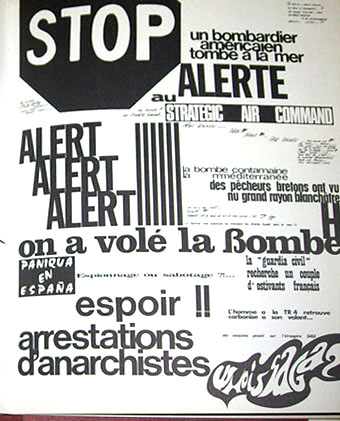
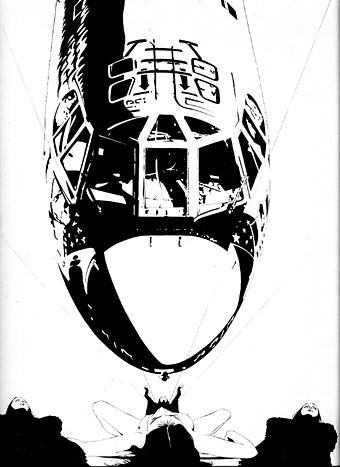

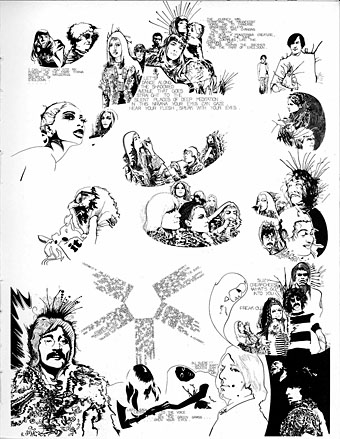
Previously on { feuilleton }
• L’Amour by Didier Moreau
• Gilles Rimbault redux
• Raymond Bertrand paintings
• Raymond Bertrand’s science fiction covers
• Gilles Rimbault revisited
• Druillet’s vampires
• The Art Nouveau dance goes on forever
• The art of Ran Akiyoshi, 1922–1982
• The art of Gilles Rimbault
• The art of Jim Leon, 1938–2002
• The art of Bertrand

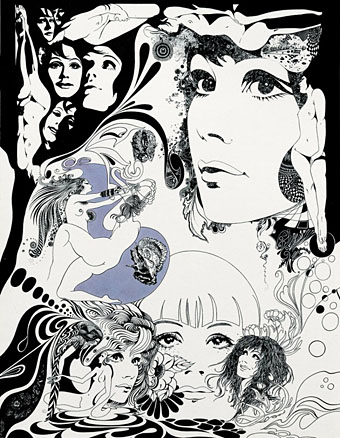
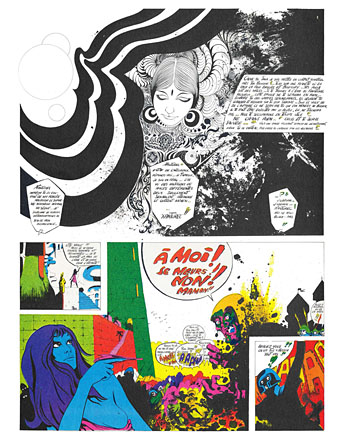
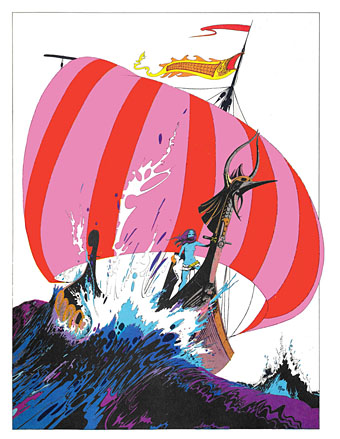
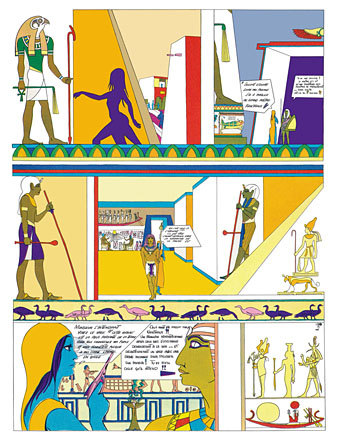
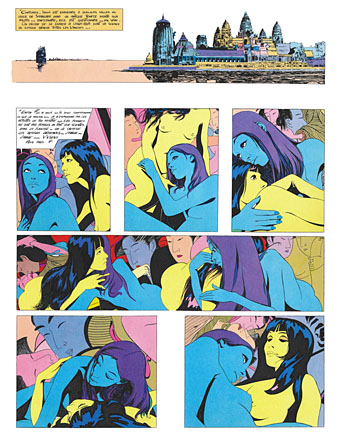
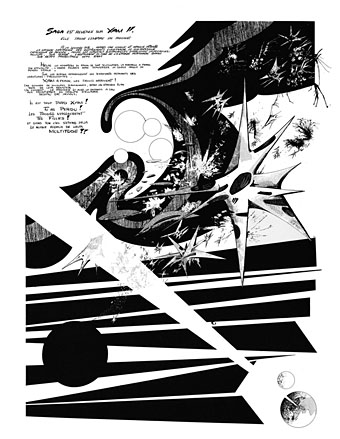
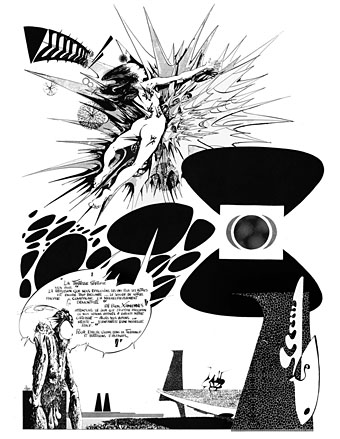
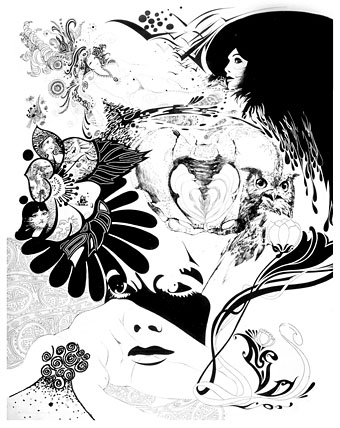
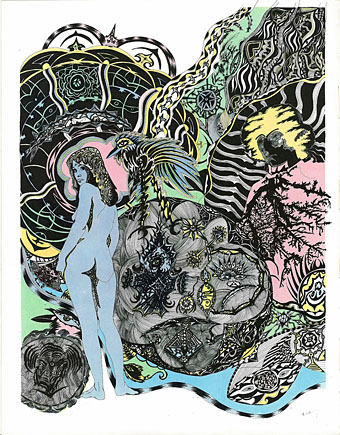
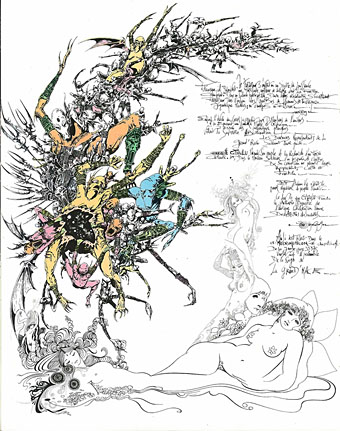
Philippe Caza’s Kris Kool
Speaking of which, the Datsuns again:
http://thedatsuns.com/release/deep-sleep/
(copies of the poster may still be available, if you want one).
Thanks, it’s good he’s getting some renewed attention. Despite being featured regularly in Heavy Metal magazine he often seemed to get overlooked by Anglophone readers.
Hi, like most other things I’ve posted on Scribd, Saga de Xam got very little attention. Some readers, yes, but hardly any likes, comments or ratings. So I didn’t bother to scan and upload chapter 7.
It is some work: The book was just too big for my scanner, every page had to be scanned twice and the pieces stitched together, straightened and spots and shadows removed and more. Also, the print is bad because the different colors are misplaced to each other. Some of that need to be taken care of, too.
I was a little surprised to find your nice blogspot here, didn’t think anybody cared.
Right now, my scanner is broken, but I hope to acquire a new one during the next weeks and do rest of the book some time after then, whenever time allows.
Unfortunately, I lost the book’s cover long time ago. Unless I find a hi-quality scan of that, it will not be included.
Hi Goldfires. My thanks for going to the trouble, I appreciate the work and the difficulty since I’ve had to scan things that way myself in the past. If you do get the chance to scan the remaining chapter I’d love to see it. If the comments here are switched off (they usually have a time limit to reduce spam comments) then you can always send me an email notification.